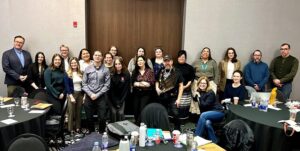Anishinabek Nation gathers with partners to explore archaeology, heritage, and cultural management

By Rick Garrick
VAUGHAN — Archaeology, heritage, and cultural management were highlighted during the Wiidookwaawag E-gnawendangig Gchi-gkendaaswin Helping Those Who Protect the Sacred Knowledge gathering, held Feb. 27 at the Novotel Toronto Vaughan Centre in Vaughan, Ont., by the Anishinabek Nation.
“I decided on this title for the gathering because it’s really an acknowledgement that the things we will be talking about today are not just about protecting physical objects or even physical people that are our ancestors,” says Kevin Restoule, government relations coordinator at the Anishinabek Nation. “Keep in mind that each one of these holds its own knowledge, some may say that each one has [its] own story to tell but it’s even more than history or stories of the past. I see it as knowledge that should guide us moving forward. One of the things I am speaking of is the sense of identity in healing that this knowledge brings about. Many of our First Nations people have experienced trauma and loss that can only truly be healed through the return of this knowledge [and] the healing of the spirit.”
The day began in a good way with a Sunrise Ceremony led by Oshkabewis Anzoked Perry McLeod-Shabogesic, after which he spoke about the spirit journey during his Traditional Teachings presentation at the gathering.
“When we come into this stage in the physical world, we’re spirits just learning how to be physical beings, we’re taught how to walk, we’re carried, we’re fed, we’re clothed, we’re taken care of,” McLeod-Shabogesic says. “And then, we learn how to do that ourselves, then we begin to break away from our parents. We live our lives and then we come back to that Elder stage. When you get through that Elder stage, then you come what we call full circle, you revert back and transition back into the infancy stage.”
McLeod-Shabogesic says his grandmother reverted back to only speaking Anishinaabemowin during that stage.
“Anishinaabemowin was her first language so she couldn’t speak English anymore,” McLeod-Shabogesic says. “We had to feed her again, we had to clothe her again, we had to wash her again. In that final stage, we prepare our family member, our Elder person, for that transition into the spirit realm.”
Naomi Recollet, archivist at the Ojibwe Cultural Foundation (OCF), spoke about the return of artifacts, including the return of the 1836 Bond Head Treaty Pipe, which had been absent for more than 180 years, through a partnership with Wiikwemkoong and Royal Ontario Museum (ROM), who had purchased the pipe from a private seller in 2020, during her Ojibwe Cultural Foundation presentation.
“November of 2022 was when that Pipe finally made its way back to the Island. That Pipe is now in the care of OCF, and myself, and my sister Shaelynn (Recollet, junior curator at OCF), along with Duke Peltier; we’re the caretakers of that Pipe until its carrier becomes known,” Recollet says, noting that OCF’s partnerships are important for the organization. “These partnerships have helped with community connections, research, training, learning opportunities, the growth of our collection, the enhancement of that collection, and overall, just being responsible caretakers.”
Paul Racher, managing principal at Archaeological Research Associates Ltd., highlighted three recommendations from a study they did for the Anishinabek Nation during his Decolonizing Indigenous Heritage in Ontario – A Critical Review of the Standards and Guidelines presentation.
“Recommendation 1: that the Duty to Consult and Accommodate and/or Free, Prior and Informed Consent be integrated into heritage management,” Racher says. “Which is to say, First Nations and Indigenous communities must be engaged at the beginning of the development process, and free, prior, and informed consent must be obtained for any activities that propose an impact on treaty and traditional territories and/or the cultural manifestations like archaeological sites that are found within.”
Racher’s other recommendations were that Indigenous heritage be managed by Indigenous communities and that the financial burden of any system to manage impacts to Indigenous heritage not be borne by First Nations and Indigenous communities.
James Hopkins and Daniel McCoy, associates at Nahwegahbow, Corbiere Genoodmagejig Barristers and Solicitors, also highlighted four recommendations about the best path forward for protecting burial, sacred, and cultural sites during their Protection of Sacred Sites Through Policy and Legislative Reform presentation.
“Recommendation 1, which has been talked about before, adopting UNDRIP (United Nations Declaration on the Rights of Indigenous Peoples) into provincial law,” Hopkins says. “In the interim, this is where I think things can be exciting and I’m an optimist and we’re all engaged, so I think we can do something here, using the language of UNDRIP in the development and implementation of intergovernmental MOUs (Memorandum of Understandings) and protocols.”
Their other recommendations were strengthening the Planning Act by requiring the participation of First Nations in the planning process; work with municipalities through partnerships to ensure the participation of First Nations in the Official Plan/Zoning process; and updating policy documents that establish standards and guidelines for consultant archaeologists.
Participants of this gathering included representatives from a range of provincial ministries including but not limited to Indigenous Affairs, Government and Consumer Services, Municipals Affairs and Housing, and Citizenship and Multiculturalism; Association of Municipalities of Ontario; Office of the Chief Coroner and Ontario Forensic Pathology Service; consultation coordinators from Anishinabek Nation member First Nations; and Chiefs of Ontario Heritage and Burials Working Group, Kee:way.


